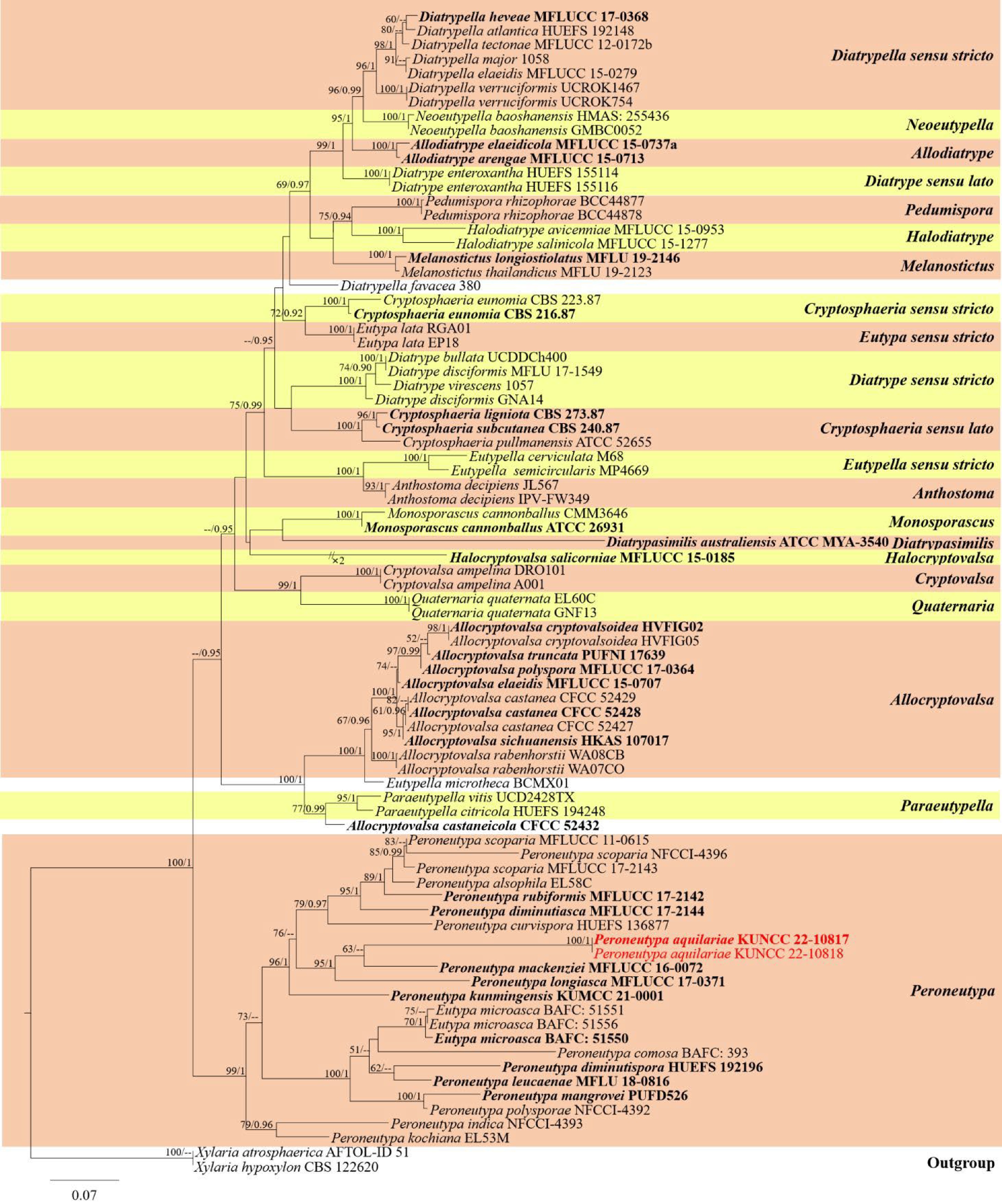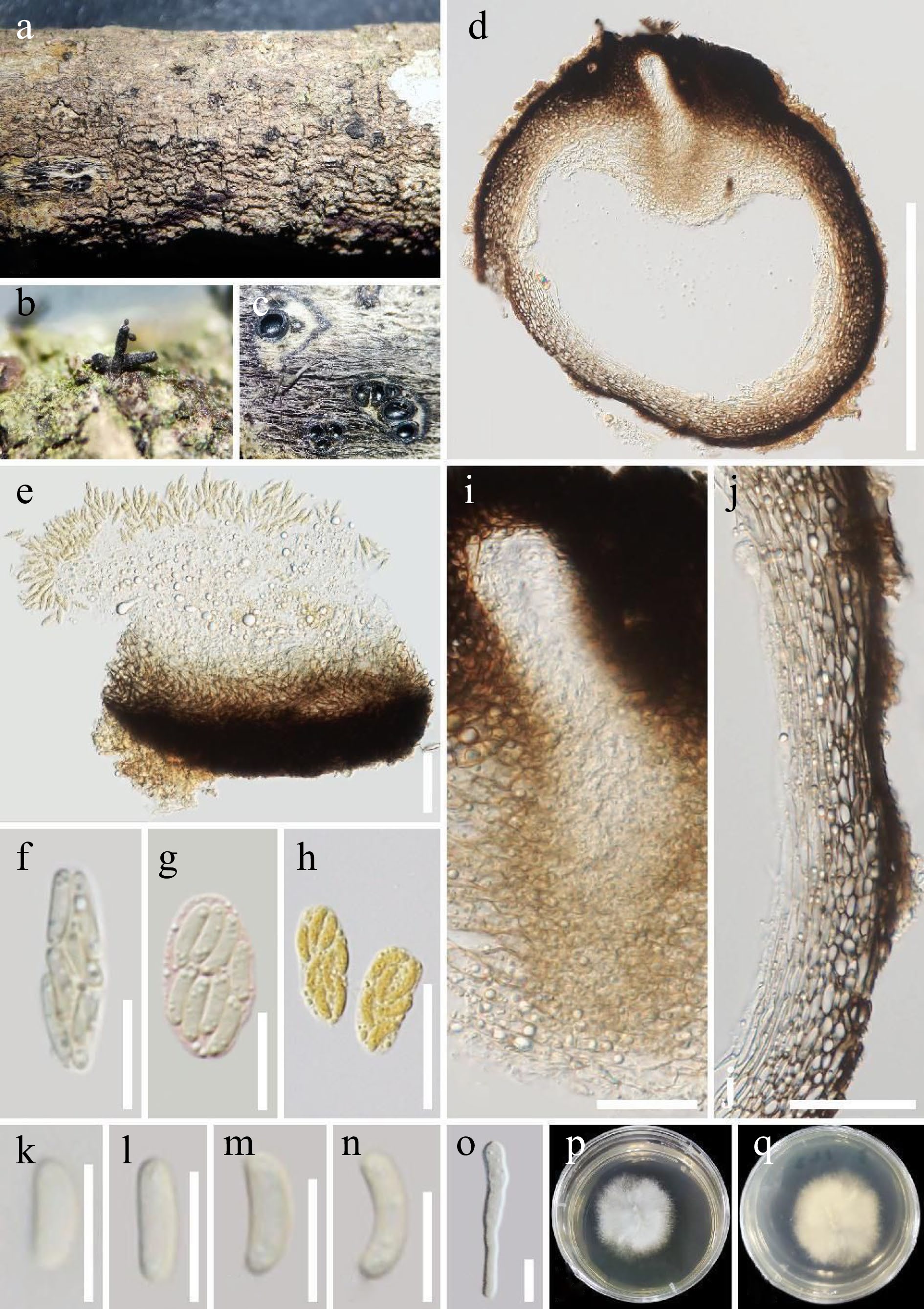-

Figure 1.
RAxML tree of Diatrypaceae based on a combined dataset of ITS and tub2 partial sequences. Bootstrap support values for maximum likelihood (ML) equal to or higher than 50% and bayesian posterior probability (BYPP) equal to or higher than 0.90 are indicated above the branches. Newly generated sequences are shown in red, while the type species are shown in bold black and red.
-

Figure 2.
Peroneutypa aquilariae (HKAS 124185, holotype). (a)–(c) Appearance of ascomata on the substrate. (d) Section through an ascoma. (e)–(h) Asci, (g) ascus stained with Congo red reagent, (h) asci stained with Melzer’s reagent). (i) Ostiole. (j) Peridium. (k)–(n) Ascospores. (o) A germinating ascospore. (p), (q) Colony on PDA medium (after 7 d in culture). Scale bars: (d) = 300 μm, (e), (j) = 50 μm, (f), (g) = 10 μm, (h) = 20 μm, (i) = 30 μm, (k)–(o) = 5 μm.
-
Table 1.
The primers and thermal cycles of PCR used in this study.
-
Species Strain number ITS tub2 Reference Allocryptovalsa castanea CFCC 52427 MW632944 – [13] Allocryptovalsa castanea CFCC 52428T MW632945 – [13] Allocryptovalsa castanea CFCC 52429 MW632946 – [13] Allocryptovalsa castaneicola CFCC 52432T MW632947 – [13] Allocryptovalsa cryptovalsoidea HVFIG02T HQ692573 HQ692524 [34] Allocryptovalsa cryptovalsoidea HVFIG05 HQ692574 HQ692525 [34] Allocryptovalsa elaeidis MFLUCC 15-0707T MN308410 MN340296 [46] Allocryptovalsa polyspora MFLUCC 17-0364T MF959500 MG334556 [17] Allocryptovalsa rabenhorstii WA07CO HQ692620 HQ692522 [34] Allocryptovalsa rabenhorstii WA08CB HQ692619 HQ692523 [34] Allocryptovalsa sichuanensis HKAS 107017T MW240633 MW775592 [20] Allocryptovalsa truncata PUFNI 17639T MK990279 – [1] Allodiatrype arengae MFLUCC 15-0713T MN308411 MN340297 [46] Allodiatrype elaeidicola MFLUCC 15-0737aT MN308415 MN340299 [46] Anthostoma decipiens JL567 JN975370 JN975407 [47] Anthostoma decipiens IPV-FW349 AM399021 AM920693 Unpublished Cryptosphaeria eunomia CBS 216.87T KT425230 KT425165 [48] Cryptosphaeria eunomia CBS 223.87 KT425231 KT425166 [48] Cryptovalsa ampelina A001 GQ293901 GQ293972 [49] Cryptovalsa ampelina DRO101 GQ293902 GQ293982 [49] Diatrypasimilis australiensis ATCC MYA-3540T NR111369 – [50] Diatrype disciformis GNA14 KR605644 – [23] Diatrype disciformis MFLU 17-1549 MW240629 – [20] Diatrypella elaeidis MFLUCC 15-0279 MN308417 MN340300 [46] Diatrypella verruciformis UCROK1467 JX144793 JX174093 [51] Eutypa lata RGA01 HQ692614 HQ692497 [34] Eutypa lata EP18 HQ692611 HQ692501 [34] Eutypa microasca BAFC: 51550T KF964566 KF964572 [52] Eutypa microasca BAFC: 51551 KF964565 KF964570 [52] Eutypa microasca BAFC: 51556 KF964567 KF964571 [52] Eutypella cerviculata M68 JF340269 – [53] Eutypella semicircularis MP4669 JQ517314 – [54] Halocryptovalsa salicorniae MFLUCC 15-0185T MH304410 MH370274 [25] Halodiatrype avicenniae MFLUCC 15-0953 KX573916 KX573931 [55] Halodiatrype salinicola MFLUCC 15-1277 KX573915 KX573932 [55] Monosporascus cannonballus CMM3646 JX971617 – [56] Monosporascus cannonballus ATCC 26931T FJ430598 – Unpublished Neoeutypella baoshanensis HMAS:255436 MH822887 MH822888 [24] Neoeutypella baoshanensis GMBC0052 MW797106 MW814878 [57] Pedumispora rhizophorae BCC44877 KJ888853 – [58] Pedumispora rhizophorae BCC44878 KJ888854 – [58] Peroneutypa alsophila EL58C AJ302467 – [15] Peroneutypa aquilariae KUNCC 22-10817T OP454038 OP572195 This study Peroneutypa aquilariae KUNCC 22-10818 OP482262 OP572196 This study Peroneutypa comosa BAFC:393 KF964568 – [52] Peroneutypa curvispora HUEFS 136877 KM396641 – [11] Peroneutypa diminutiasca MFLUCC 17-2144T MG873479 MH316765 [18] Peroneutypa diminutispora HUEFS 192196T KM396647 – [11] Peroneutypa indica NFCCI-4393 MN061368 MN431498 [25] Peroneutypa kochiana EL53M AJ302462 – [15] Peroneutypa kunmingensis KUMCC 21-0001T MZ475070 MZ490589 [19] Peroneutypa leucaenae MFLU 18-0816T MW240631 MW775591 [20] Peroneutypa longiasca MFLUCC 17-0371T MF959502 MG334558 [17] Peroneutypa mackenziei MFLUCC 16-0072T KY283083 KY706363 [12] Peroneutypa mangrovei PUFD526T MG844286 MH094409 [24] Peroneutypa polysporae NFCCI-4392 MN061367 MN431497 [25] Peroneutypa scoparia MFLUCC 11-0615 KU940152 – [59] Peroneutypa scoparia MFLUCC 17-2143 MG873478 MH316764 [18] Quaternaria quaternata EL60C AJ302469 – [15] Quaternaria quaternata GNF13 KR605645 – [23] Xylaria atrosphaerica AFTOL-ID 51 DQ491487 – Unpublished Xylaria hypoxylon CBS 122620 AM993141 KX271279 [60] The newly generated sequences are in black bold, superscripted 'T' indicates ex-type, and '–' indicates sequence unavailable. Table 2.
Species, strain numbers, and GenBank accession numbers used in the phylogenetic analyses.
-
Species Ascostromata Ascomata Ostiolar canal Peridium Paraphyses Asci Ascospores Countries Hosts References P. alsophila Slightly or well-developed, less than 1 mm long N/A Necks not prominent N/A N/A Apical apparatus J+ N/A Argelia, France Arthrocnemum fruticosum [15,16] P. aquilariae Slightly or well-developed,
0.5–1.5 mm wide,
1–6 locules300–570 μm (excluding necks) With 200–300 μm long necks, 20–40 μm wide, without periphysis 35–70 μm wide Absent 18.3 × 5.8 μm, short pedicellate or non-pedicellate, J- apical ring, apically rounded to truncate 6.3 × 2 μm,
hyaline to pale
yellow, oblong
to allantoidChina Aquilaria sinensis This study P. bellula Immersed, scattered Globose Long necks N/A N/A Minimum, 5–6-spored, hyaline Oblong, with granules N/A Arundo donax [61] P. coffeae 450–900 × 350–650 μm N/A 700–1,500 × 80–100 μm 20–25 μm wide N/A 23–25 × 4–5 μm, pedicellate 4.5–6 × 1–1.5 μm, allantoid Central African Republic Coffea robusta [62] P. comosa Slightly or well-developed N/A Necks very long, over 1 mm, prominent N/A N/A Apical apparatus J+ / J− N/A Argentina Celtis tala [16,52] P. corniculata Multi-ascoma N/A Prominent N/A N/A N/A N/A America Prunus melanocarpa [9,63] P. curvispora Poorly-developed, 0.6–3 mm wide,
22 ascomata per stroma300–700 μm wide 400–800 μm long, prominent N/A Absent 9–16.5 × 4–6 μm, long pedicellate, apex truncate 3–5 × 1–2 μm, allantoid,
strongly curvedBrazil Unidentified wood [11] P. cylindrica 3–4 mm,
8–10 locules1 mm 1–2.5 mm long N/A Absent 10–20 × 4–5, clavate, pedicellate 4–5 × 2, hyaline, curved South Africa Unidentified wood [64] P. cyphelioides 1–3 mm 300 μm 1–2 mm long N/A N/A 15 × 4–5 μm 4 × 1 μm, allantoid Philippines Streblus asper [65] P. diminutiasca With poorly-developed interior, 1.2–1.4 mm wide, 1–10 locules 147–218 μm (excluding necks) 193 × 48 μm wide, long neck, periphysate 15–32 μm wide 4–7 μm wide, dense, septate 22 × 4 μm, long pedicellate, with a J− subapical ring, apically rounded to truncate 4.2 × 1.7 μm, hyaline to pale
yellowish, allantoidThailand Unidentified wood [18] P. diminutispora Absent or with poorly-developed, isolated or in groups of up to seven 400–700 μm 200–400 μm long N/A Absent Long pedicellate, with a J− apical rings, apex truncate Allantoid, slightly to moderately curved, yellowish in mass Brazil Unidentified wood [11] P. discriminis 1 mm 200 μm 1 mm long N/A N/A 12–14 × 4 μm 5–6 × 1.5–2 μm India, Philippines Ficus racemosa, Macaranga tanarius, Streblus asper [65] P. exigua N/A N/A 500–700 μm long N/A N/A 11–16 × 3–6 μm (sporiferous part) 3–3.5 × 1–1.5 μm Brazil Citrus aurantium [66] P. gliricidiae Interior of the stroma not developed N/A Necks not prominent N/A N/A 10–16 µm, J+ Allantoid Philippines Gliricidia sepium [16] P. heteracanthoides N/A 300 μm N/A N/A Absent 16 × 3.5 μm 3–4 × 1 μm, allantoid, hyaline, with granules Singapore Cassiae sp., Heveae brasiliensis [67] P. indica Well-developed 375 × 202 µm 100–250 µm wide, with moderate neck 100–350 µm long, periphysate 15–35 µm wide 1–2 µm 42 × 3.5 µm,
short pedicellate, apically rounded to truncate, with a J– apical ring5.5 × 1.3 µm, hyaline, straight to allantoid, light brown in mass India Suaeda monoica [25] P. iranica 0.5–2 mm, 3–16 locules 300–500 μm 40–120 μm, periphysate 30–55 μm wide Septate, hyaline 13.5 × 3.6 μm, with a J+ apical ring 3.6 × 1 μm, hyaline, allantoid Iran Wisteria sinensis [68] P. kochiana Interior of the stroma not developed N/A Necks not prominent N/A N/A 18–28 µm long, J+ Allantoid Russia, Spain Atriplex halimus [15,16] P. komonoensis N/A 250–450 × 200–350 μm 1–1.2 mm long N/A N/A 30–38 × 3.5–4 μm, long pedicellate 3–4 × 1–1.5 μm, allantoid French Equatorial Africa Hevea brasiliensis [69] P. kunmingensis Absent or with poorly-developed interior 260 × 317 μm (excluding neck) 140 × 100 μm wide, long neck, periphysate 30–60 μm wide Septate, hyaline 26 × 4.1 μm, straight or slight curved, hyaline, long pedicel up to 16 μm, with a J– apical ring 4.2 × 1.3 μm, hyaline to pale grey, oblong to allantoid China Unidentified wood [19] P. leucaenae N/A 655 × 525 μm 275–350 μm long neck, periphysate 22–43 μm wide 3.2–7 μm wide, wider at the base, long, septate, 33 × 4.2 μm, pedicel 17–27 μm long, J+ apical ring Yellowish-brown, ellipsoidal to
cylindrical or elongate-allantoidThailand Leucaena leucocephala [20] P. lignicola 609–685 μm high, 1,196–1,246 μm, 4–6 locules 448–662 × 355–445 μm Long neck 62–92 μm wide N/A 16 × 6 μm, sessile, hyaline 6 × 2 μm, elongate-allantoid, straight to slightly curved Thailand On decaying wood submerged in a freshwater stream [28] P. longiasca N/A 180–450 × 170–390 µm 20–50 μm wide, 190–440 μm long 14–47 μm wide N/A Short to long pedicellate, apically rounded to truncate with indistinct J– subapical ring 5.8 × 2 μm, hyaline, oblong to allantoid Thailand Hevea brasiliensis [17] P. mackenziei With poorly-developed interior, 1.2–2.2 mm wide, multi-ascoma 466 × 356 μm 265 × 100 μm, ostiolar canal with long neck, periphysate 45–65 μm wide 2.5–4.5 μm wide, dense, filamentous, aseptate, hyaline 17.7 × 4.2 μm, sessile, apically rounded to truncate, with a J– apical ring 5.6 × 1.6 μm, subhyaline to
pale yellowish,
elongate allantoidThailand Unidentified wood [12] P. macroceras 600–1,500 × 500–650 μm N/A 1,500–2,500 × 100–120 μm N/A N/A 30–35 × 4–4.5 μm, long pedicellate 4–5 × 1.2–1.5 μm, allantoid Central African Republic Coffea robusta [62] P. macrorostrata 1,500–2,000 × 350–500 μm N/A N/A N/A N/A 25–30 × 4–5 μm, pedicellate 4–6 × 1.5–2 μm, allantoid French Equatorial Africa Hevea brasiliensis [69] P. mangrovei Absent or poorly-developed, up to four in groups 375 × 202 μm 50–85 μm wide, with moderate neck length 100–350 μm, periphysate 15–35 µm wide 1–2 μm wide, septate, longer than asci 17 × 3.5 μm, short pedicellate, apically rounded to truncate, with a J– apical ring Hyaline to pale yellow, straight to allantoid India Avicennia marina [24] P. multistromata 400–900 × 200–700 μm 270–450 × 200–300 μm N/A N/A Absent 30–40 × 3–5 μm, (sporiferous part: 14–18 μm), long pedicellate, 8-spored 3–4 × 0.75–1 μm, hyaline, allantoid Cote d'Ivoire Coffea canephora [70] P. obesa Slightly or well-developed, spiny or bristly appearance to the stromatic surface, black line present N/A Necks prominent N/A N/A N/A 3–7 µm long, strongly curved Argentina, Zaire Unidentified
wood[16] P. perseae 500–700 × 300–500 μm,
5–6 locules300–600 × 150–200 μm N/A N/A Absent 18–26 × 4–6.5 μm, 8-spored, hyaline 5–6 × 1.5–2 μm, hyaline Morocco Persea americana [71] P. philippinarum 2–3 locules 200 μm 300–1000 μm long N/A N/A 15 × 4–5 μm 4 × 1.5 μm, allantoid Philippines Streblus asper [65] P. polymorpha N/A N/A N/A N/A N/A N/A N/A Cote d'Ivoire Manihot esculenta [72] P. polysporae N/A 286 × 223 µm 113 × 60 µm, periphysate 15–50 µm wide Septate, hyaline 113 × 12 µm, polysporous 9 × 1.8 µm, hyaline to pale yellow, allantoid India Suaeda monoica [25] P. rubiformis With poorly-developed interior, 1–1.4 mm wide, 1–10 locules 109 × 159 μm (excluding necks) 176 × 52 μm, roundish, prominent ostioles in the centre, rubus-like or star-like in shape, periphysate 20–25 μm wide 7–11 μm wide, septate, hyaline 50 × 5 μm, short pedicellate, apically rounded to truncate, with a J- subapical ring 4.3 × 1.6 μm, hyaline to pale yellowish, elongate-allantoid Thailand Unidentified wood [18] P. scoparia Not developed or with poorly-developed interior,1.2–2 mm wide, 4–8 locules 256 × 266 μm 441 × 105 μm,
long necks,
prominent, periphysate20–35 μm wide Septate, hyaline 22 × 4.5 μm, long pedicellate, apically rounded to truncate, with a J– subapical ring 4.1 × 1.5 μm, oblong to allantoid, sometimes slightly curved Argentina, Chile, Czech Republic, France, India, Iran, Italy, Paraguay, Sweden, Thailand Acer pseudoplatanus, Actinidia deliciosa, Avicennia marina, bamboo culms, Gleditsia sp., Juglans regia, Robinia pseudoacacia, Vaccinium corymbosum [16,18,25,59] P. variabilis N/A 400–500 μm 700–2500 × 100–200 μm N/A N/A 12–18 × 3 μm (sporiferous part), tapering pedicel 3–5 × 1.5–2 μm, greenish-hyaline, cylindric, curved Sri Lanka Unidentified herbaccous [73] Host and location information of taxa extracted from the listed references and Farr & Rossman[74]. The symbol “N/A" denotes no information available or not mentioned in given papers, and the new species is in black bold. Table 3.
Morphological characteristics, host, and location information of Peroneutypa species.
Figures
(2)
Tables
(3)